Water-Efficient Landscape Gardens in April
Home » Fair Oaks Horticulture Center » WEL Gardens » April in the WEL
The WEL gardens at the Fair Oaks Horticulture Center are open to the public seven days a week from sunrise to sunset for self-guided tours.
Wheelchair accessible, the gardens feature natives, commonly available perennials, trees, shrubs, and plants from other Mediterranean climates that do well with less water during our long, hot, dry summers and tolerate our chilly, damp Sacramento County winters. Most plants are labeled and many are UC Davis Arboretum All-Stars. The landscape demonstrates how home gardeners can be smart about using the water we have to create beautiful landscapes. (For more information see Gardening with Limited Water.)
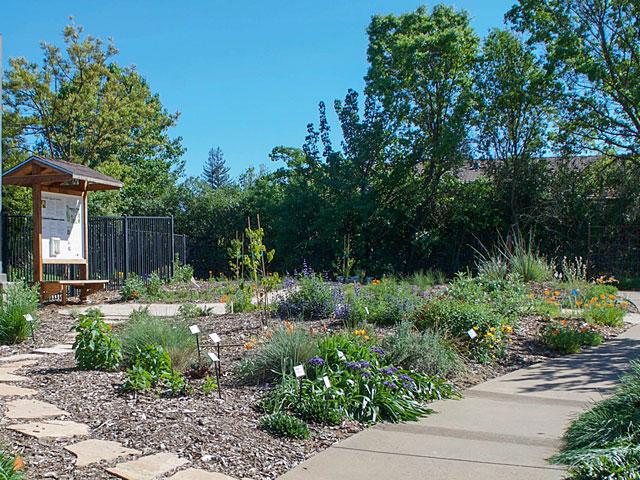
Spring colors and new growth sparkle and delight visitors. Especially lovely now are the lavender, Peruvian scilla, Yankee Point ceanothus and Jupiter’s beard. Contrasting orange California poppies, golden Carolina jessamine and white potato vines dot and accent the walkways and patios. Brilliant blue rosemary and sparkling rose buds and blooms abut fresh green perennial leaves pushing out of the mulch, budding shrubs and trees. Many salvias and penstemons are also starting to bloom. Flowering spring bulbs welcome sprouting ornamental grasses. Beneficial insects and bees flit from blossom to blossom while birds keep watch from above. See the Spring plant list for information on several of our favorite plants.
Garden tasks this month include weeding out newly germinating annual weeds such as bedstraw, cut leaf geranium and oxalis before they set seed, controlling bindweed and pulling up oak and other tree sprouts. See this resource to help you identify and control weeds . We will also be shaping up our rosemary plants to prevent woodiness by trimming back selected branches by half, taking care not to cut into woody stems. In the native garden we will be reviewing the growth of the manzanitas, California golden current and coast silktassel and pruning as needed.
In addition to the plants, pathways, patios, raised planters, drip irrigation, a dry creek bed and permeable pavement demonstrate water wise, sustainable alternatives for gardeners who are considering replacing or reducing their lawns.
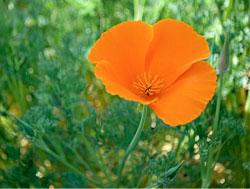
|
Eschscholzia californica Our beloved state flower is an easy to grow annual. In fact if it is happy, it will reseed abundantly. After the first wave of blossoms it can be cut or mowed to one inch stems and watered for rebloom. |
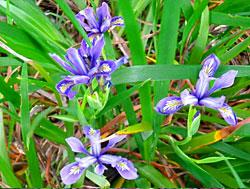
|
Iris douglasiana Pacific Coast hybrid irises are the descendants of years of hybridizing (by plant breeders since the 1920s) using the wild iris, Iris douglasiana, found primarily along the coast from southwestern Oregon south to Santa Barbara. Many of these hybrids grow well with little maintenance in well drained soil, with low summer water and shade from the hot afternoon summer sun. The white "Canyon Snow' is a UC Davis Arboretum All-Star.
|
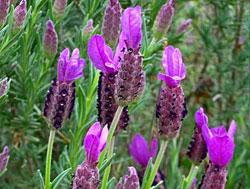
|
Lavandula stoechas 'Otto Quast' This showy, shrubby lavender, thrives in our sunny, dry climate. A favorite of bees, butterflies and other beneficial insects, it starts blooming in early spring. It is another UC Davis Arboretum All-Star. |
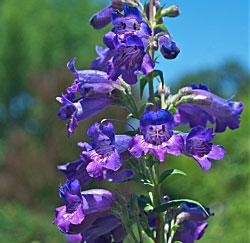
Penstemon 'Midnight'
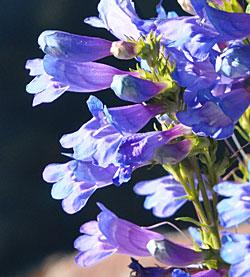
Penstemon 'Margarita B.O.P.'
|
Penstemon spp. Many of these primarily North American natives have been hybridized in Europe since the 1800s and returned to the United States where their popularity is now on the rise. They are drought tolerant, sun loving, showy perennials with tubular flowers in many colors on tall stalks that require well drained soil. Beloved by hummingbirds, they bloom all summer long with deadheading. We have at least eight varieties blooming in our garden including the California native Penstemon heterophyllus ‘Margarita B.O.P.’ (a UC Davis Arboretum All-Star) and the Penstemon hybrids ‘Garnet’ and ‘Midnight’ shown here. |
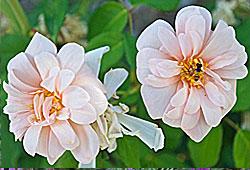
|
Rosa 'Perle d'Or' Dating from 1884, this drought tolerant, virtually pest free relatively thornless, fragrant shrub rose sports clusters of apricot colored blossoms almost year round. Another UC Davis Arboretum All-Star, it requires full sun and pruning to shape in the winter. |
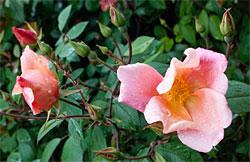
|
Rosa x odorata 'Mutabilis' The Butterfly rose is a large shrub rose that's a UC Davis Arboretum All-Star for good reason. First noted by European botanists in 1896, it likely originated in China. It blooms nearly year round and attracts bees and other beneficial insects. It does well with less water, and tolerates our soils. Although this rose can tolerate some shade, it does not do well in windy sites. Attractive blooms begin as scarlet buds and mutate progressively into light yellow, then pink, then crimson blossoms (that some have likened to butterflies). Newly sprouted canes are deep red, complementing the flowers and the lush foliage. Nearly maintenance free, Mutabilis can be pruned in winter to keep the plant more compact. |
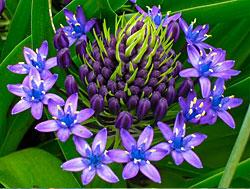
|
Scilla peruviana |



